Endophytic Pestalotiopsis species associated with Rhododendron in Cangshan Mountain, Yunnan Province, China
- PMID: 36338052
- PMCID: PMC9631938
- DOI: 10.3389/fmicb.2022.1016782
Endophytic Pestalotiopsis species associated with Rhododendron in Cangshan Mountain, Yunnan Province, China
Abstract
Rhododendron is an essential ornamental plant that is abundant in Yunnan province. In Cangshan Mountain, Yunnan, China, 61 species of Rhododendron have been reported. Endophytic fungi are internal plant tissue inhabitants that do not harm the host. It has emerged as an exciting research topic as they have the potential to provide numerous secondary metabolites. This study is focused on taxonomic novelties and new host records of endophytic fungi associated with Rhododendron plants collected from Cangshan Mountain in Yunnan Province, China. Pestalotiopsis fungi are associated with a vast array of plant species worldwide. In this study, fresh leaves of Rhododendron cyanocarpum, Rhododendron decorum, and Rhododendron delavayi were collected from Cangshan Mountain, Yunnan Province, China. Endophytic Pestalotiopsis fungi associated with Rhododendron were characterized based on phylogenetic analyses of combined ITS, TEF1-α, and TUB genes along with morphological characteristics. Six new species (Pestalotiopsis appendiculata, Pestalotiopsis cangshanensis, Pestalotiopsis daliensis, Pestalotiopsis fusoidea, Pestalotiopsis rosarioides, and Pestalotiopsis suae) and a new host record (Pestalotiopsis trachicarpicola) are described. Detailed descriptions and color photo plates of these species are provided. It is the first time that the endophytic fungi of Rhododendron plants in Cangshan Mountain have been studied.
Keywords: Sordariomycetes; endophytic fungi; morphology; phylogeny; six new species.
Copyright © 2022 Gu, Bao, Shen, Su, Li and Luo.
Conflict of interest statement
The authors declare that the research was conducted in the absence of any commercial or financial relationships that could be construed as a potential conflict of interest. The reviewer KC declared a shared affiliation with the authors D-FB and H-WS to the handling editor at the time of review.
Figures
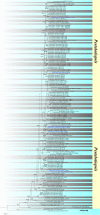
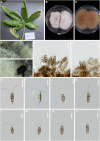
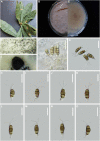
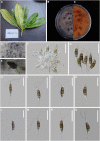

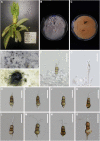

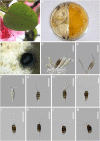
Similar articles
-
Morphology and Multi-Gene Phylogeny Reveal Pestalotiopsis pinicola sp. nov. and a New Host Record of Cladosporium anthropophilum from Edible Pine (Pinus armandii) Seeds in Yunnan Province, China.Pathogens. 2019 Dec 4;8(4):285. doi: 10.3390/pathogens8040285. Pathogens. 2019. PMID: 31817121 Free PMC article.
-
Morphological and phylogenetic analyses reveal eight novel species of Pestalotiopsis (Sporocadaceae, Amphisphaeriales) from southern China.MycoKeys. 2024 Oct 9;109:207-238. doi: 10.3897/mycokeys.109.131000. eCollection 2024. MycoKeys. 2024. PMID: 39421404 Free PMC article.
-
Pestalotiopsis Species Associated with Blueberry Leaf Spots and Stem Cankers in Sichuan Province of China.Plant Dis. 2023 Jan;107(1):149-156. doi: 10.1094/PDIS-07-21-1550-RE. Epub 2023 Jan 20. Plant Dis. 2023. PMID: 35666222
-
Pestalotiopsis trachicarpicola, a novel pathogen causes twig blight of Pinus bungeana (Pinaceae: Pinoideae) in China.Antonie Van Leeuwenhoek. 2021 Jan;114(1):1-9. doi: 10.1007/s10482-020-01500-8. Epub 2020 Nov 27. Antonie Van Leeuwenhoek. 2021. PMID: 33245453 Review.
-
[Research advances in endophytic fungi of mangrove].Ying Yong Sheng Tai Xue Bao. 2007 Apr;18(4):912-8. Ying Yong Sheng Tai Xue Bao. 2007. PMID: 17615893 Review. Chinese.
Cited by
-
Identification and Pathogenicity of Pestalotioid Species on Alpinia oxyphylla in Hainan Province, China.J Fungi (Basel). 2024 May 22;10(6):371. doi: 10.3390/jof10060371. J Fungi (Basel). 2024. PMID: 38921358 Free PMC article.
-
Pestalotiopsis (Amphisphaeriales, Sporocadaceae) species including six new taxa inhabiting pines from different climate zones in China.IMA Fungus. 2025 Jun 10;16:e151614. doi: 10.3897/imafungus.16.151614. eCollection 2025. IMA Fungus. 2025. PMID: 40538769 Free PMC article.
-
Paramirandinaguttulata (Microthyriaceae, Microthyriales), a new lignicolous freshwater fungi from a plateau lake in Yunnan Province, China.Biodivers Data J. 2024 Nov 22;12:e137989. doi: 10.3897/BDJ.12.e137989. eCollection 2024. Biodivers Data J. 2024. PMID: 39619292 Free PMC article.
-
Pestalotiopsis jiangsuensis sp. nov. Causing Needle Blight on Pinus massoniana in China.J Fungi (Basel). 2024 Mar 21;10(3):230. doi: 10.3390/jof10030230. J Fungi (Basel). 2024. PMID: 38535238 Free PMC article.
-
Exploring ascomycete diversity in Yunnan II: Introducing three novel species in the suborder Massarineae (Dothideomycetes, Pleosporales) from fern and grasses.MycoKeys. 2024 Apr 16;104:9-50. doi: 10.3897/mycokeys.104.112149. eCollection 2024. MycoKeys. 2024. PMID: 38665970 Free PMC article.
References
-
- Ariyawansa H. A., Hyde K. D. (2018). Additions to Pestalotiopsis in Taiwan. Mycosphere. 9 999–1013. 10.5943/mycosphere/9/5/4 - DOI
-
- Ariyawansa H. A., Hyde K. D., Jayasiri S. C., Buyck B., Chethana K. W., Dai D. Q., et al. (2015). Fungal diversity notes 111–252-taxonomic and phylogenetic contributions to fungal taxa. Fungal Divers. 75 27–274. 10.1007/s12155-012-9194-2 - DOI
LinkOut - more resources
Full Text Sources

